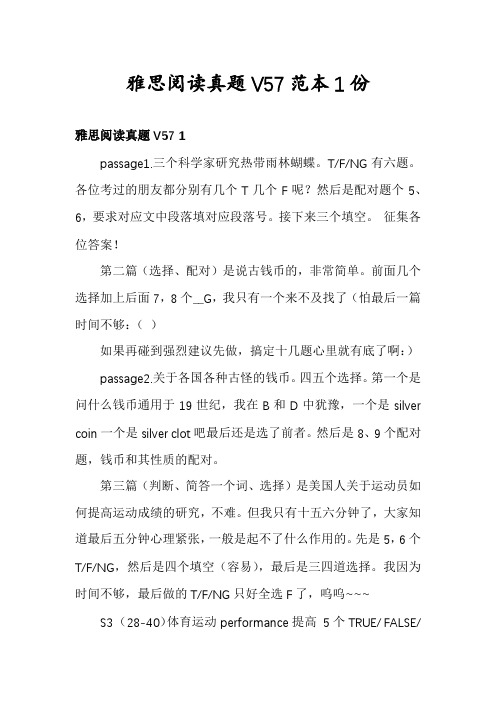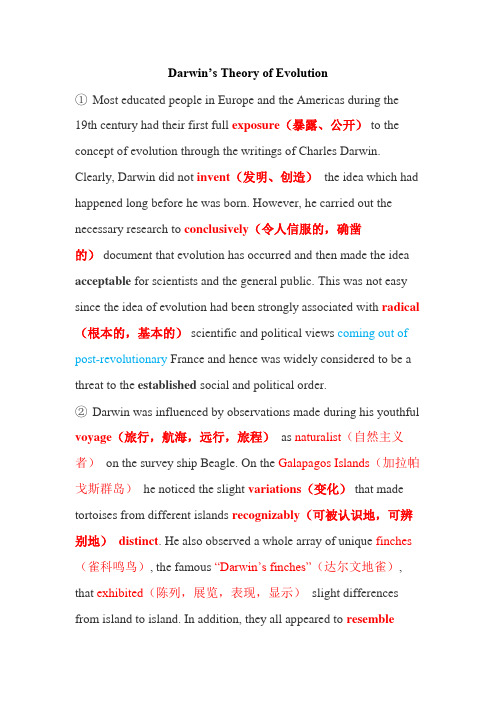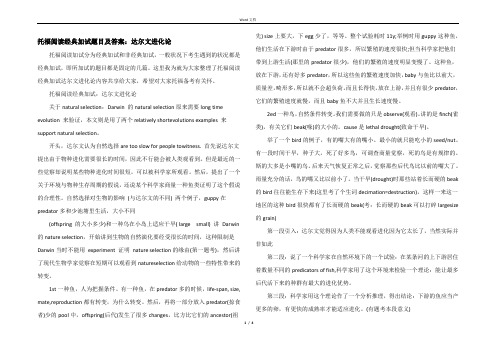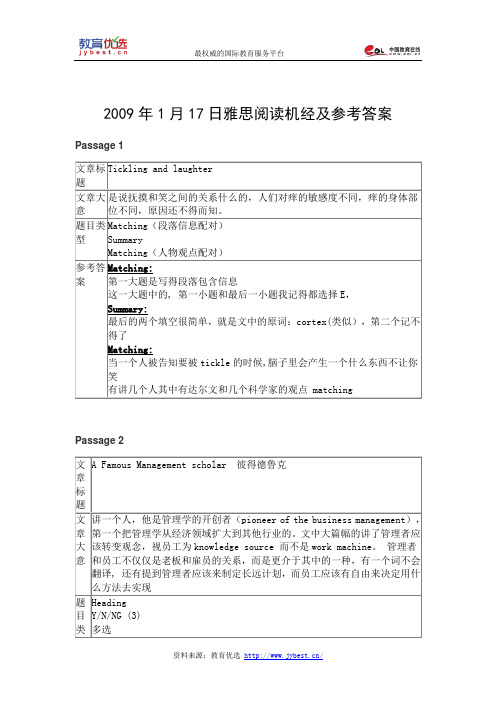雅思阅读(达尔文)
雅思阅读真题V57范本1份

雅思阅读真题V57范本1份雅思阅读真题V57 1passage1.三个科学家研究热带雨林蝴蝶。
T/F/NG有六题。
各位考过的朋友都分别有几个T几个F呢?然后是配对题个5、6,要求对应文中段落填对应段落号。
接下来三个填空。
征集各位答案!第二篇(选择、配对)是说古钱币的,非常简单。
前面几个选择加上后面7,8个__G,我只有一个来不及找了(怕最后一篇时间不够:()如果再碰到强烈建议先做,搞定十几题心里就有底了啊:)passage2.关于各国各种古怪的钱币。
四五个选择。
第一个是问什么钱币通用于19世纪,我在B和D中犹豫,一个是silver coin一个是silver clot吧最后还是选了前者。
然后是8、9个配对题,钱币和其性质的配对。
第三篇(判断、简答一个词、选择)是美国人关于运动员如何提高运动成绩的研究,不难。
但我只有十五六分钟了,大家知道最后五分钟心理紧张,一般是起不了什么作用的。
先是5,6个T/F/NG,然后是四个填空(容易),最后是三四道选择。
我因为时间不够,最后做的T/F/NG只好全选F了,呜呜~~~ S3 (28-40)体育运动performance提高5个TRUE/ FALSE/NOT GIVE 4 conclusions 3 choice1.对体育成绩有记录开始于ABOUT 1900,我犹豫半天选对,原句:有记录于EARLY IN 19世纪,1904年的奥林匹克百米成绩是。
马拉松是2:55分,而1999年新的记录是2:05,提高了30% 第一段完毕2.遗传可以FULLY完全解释为什么有些人成绩好,F,原文:遗传是最重要的原因,但也就能占1/3,没一个人能给出完全的合理的解释,__G弄好了比1/3还强3.好基因的父母他们自己一定是很出色的运动员NOT GIVEN,原文:你要是想当好运动员,你一定好好挑选父母。
4.有了记录数据后,很多人可以在很早的年纪就被发现体育特长T原句:因为有基因数据和国际比赛重奖,所以可以使很早运动员就被发现。
时间就像海绵里的水,挤一挤,总还是有的

时间就像海绵里的水,挤一挤,总还是有的第一篇范文:雅思阅读材料之时间就像海绵里的水挤挤总会有的智课网IELTS备考资料雅思阅读材料之时间就像海绵里的水挤挤总会有的出国英语考试有哪些雅思6.5是什么水平雅思阅读评分标准托福阅读评分标准雅思和托福的区别Does This Sound Familiar?这听上去很熟悉是吗?Everyone seems to complain about being busy nowadays. That’s no surprise considering the wealth of information, activities and opportunities that we have at our fingertips when compared to just a few decades ago, but it also means that one of our most precious resources C time C is becoming even harder to control.如今每个人似乎都在抱怨自己很忙。
考虑到我们触手可及的信息、活动和机会的数量和几十年前相比已经不可同日而语,这并不奇怪。
但这也意味着我们最珍贵的资源之一――时间――正在变得更加难以控制。
That said, there are people who are achieving amazing things every day in the same 24 hours that we all have available. So what do they know that most people don’t?即便如此,还是有人每天都做到了不可思议的事情,而他们和我们拥有的同样都是每天24小时。
他们知道什么大部分人不知道的秘诀呢?What’s Really Important to You?什么是对你真正重要的?We’re surrounded by distractions that will st eal our time if we’re not careful. Everyone is busy for 24 hours a day but it’s important to remember that we’re all busy doing different things.我们周围充满了让我们分心的东西,一不小心,我们的时间就会被偷走。
雅思阅读(达尔文)

Darwin’s Theory of Evolution①Most educated people in Europe and the Americas during the19th century had their first full exposure(暴露、公开) to the concept of evolution through the writings of Charles Darwin. Clearly, Darwin did not invent(发明、创造)the idea which had happened long before he was born. However, he carried out the necessary research to conclusively(令人信服的,确凿的) document that evolution has occurred and then made the idea acceptable for scientists and the general public. This was not easy since the idea of evolution had been strongly associated with radical(根本的,基本的) scientific and political views coming out of post-revolutionary France and hence was widely considered to be a threat tothe established social and political order.②Darwin was influenced by observations made during his youthful voyage(旅行,航海,远行,旅程)as naturalist(自然主义者)on the survey ship Beagle. On the Galapagos Islands(加拉帕戈斯群岛)he noticed the slight variations(变化)that made tortoises from different islands recognizably(可被认识地,可辨别地)distinct. He also observed a whole array of unique finches(雀科鸣鸟), the famous “Darwin’s finches”(达尔文地雀), that exhibited(陈列,展览,表现,显示)slight differences from island to island. In addition, they all appeared to resemble(与…相像,类似于), butdiffer from, the common finch on the mainland(大陆,本土)of Ecuador(厄瓜多尔), 600 miles to the east. Patterns inthe distribution and similarity of organisms(有机物,有机体,生物)had an important influence of Darwin’s thinking.③Darwin’s theory of evolution entails(牵涉,需要,使必要)the following fundamental ideas. Firstly, species change over time and space. The representatives(代表)of species living today differ from those that lived in the recent past, and populations indifferent geographic regions today differ slightly in form or behavior. Secondly, all organisms share common ancestors(祖先)with other organisms. Over time(随着时间的过去), populations may diverge(分开、偏离) into different species which share a common ancestral(祖先的)population. This means far enough back in time(足够早的时间), any pair of organisms shares a common ancestor. For example, humans shared a common ancestor with chimpanzees about eight million years ago, with whales about 60 million years ago, and with kangaroos(袋鼠)over 100 million years ago. Thirdly, evolutionary change is gradual and slow in Darwin’s view. This claim(要求,声称)was supported by the long episodes(插曲,片段) of gradual change in organisms in the fossil record and the fact that no naturalist had observed the sudden appearance of a new species in Darwin’s tim e.④These first three ideas were already under discussion among earlier and contemporaneous(同时期的,同时代的) naturalists working on the “species problem” as Darwin began his research. Darwin’s most original contributions were the mechanism (机制)of natural selection and copious(丰富的,大量的)amounts of evidence for evolutionary change from many sources, as are demonstrated in his famous book The Origin of Species by Means of Natural Selection published in 1859. Darwin and his fellow naturalist Alfred Wallace independently came to the conclusion that geologically(从地质上来说)older species of life gave rise to geologically younger and different species through the process of natural selection.⑤Generally speaking, Darwin’s process of natural selection has four components(成分,组分). The first is variation. That is, organisms within populations exhibit(呈现,证明) individual(个人的,个别的,独特的)variation in appearance and behavior, involving body size, hair color, facial markings, voice properties, or number of offspring. The second is inheritance(遗传,继承), which means some traits(特性,特点)are heritable andare consistently passed on from parent to offspring, whereas other traits are strongly influenced by environmental conditions and show weak heritability. The third is high rate of population growth. Thissuggests that most populations have more offspring each year than local resources can support, leading to a struggle for resources and consequently(所以,因此)substantial(大量的,牢固的)mortality(死亡数)within each generation. The final component refers to(涉及,指的是,适用于)the differential(差别的) survival and reproduction among species. According to Darwin, individuals possessing traits well suited for the struggle for local resources are more likely to survive and to reproduce, passing those desirable(令人满意的,可取的)variations on to the next generation.⑥Some variations are helpful. For example, any variation that increases an antelope’s(羚羊)speed may help it elude(逃避,理解不了,抓不到)predators(食肉动物). Any variation that increases water retention(保留,滞留)in a desert plant will favor survival of that plant to reach maturity(成熟,完备). Those animals and plants that survive to maturity and are able to reproduce become the parents of the next generation, passing on the favorable variations. Darwin called the process by which such favorable(有利的)variations are passed from generation to generation natural selection.。
托福阅读经典加试题目及答案:达尔文进化论

托福阅读经典加试题目及答案:达尔文进化论托福阅读加试分为经典加试和非经典加试,一般状况下考生遇到的状况都是经典加试,即所加试的题目都是固定的几篇。
这里我为就为大家整理了托福阅读经典加试达尔文进化论内容共享给大家,希望对大家托福备考有关怀。
托福阅读经典加试:达尔文进化论关于natural selection:Darwin 的natural selection原来需要long time evolution 来验证,本文则是用了两个relatively shortevolutions examples 来support natural selection。
开头,达尔文认为自然选择are too slow for people towitness. 首先说达尔文提出由于物种进化需要很长的时间,因此不行能会被人类观看到。
但是最近的一些觉察却说明某些物种进化时间很短,可以被科学家所观看。
然后,提出了一个关于环境与物种生存周期的假说,还说某个科学家商量一种鱼类证明了这个假说的合理性。
自然选择对生物的影响(与达尔文的不同) 两个例子,guppy在predator多和少池塘里生活,大小不同(offspring 的大小多少)和一种鸟在小岛上适应干旱( large small) 讲Darwin 的nature selection,开始讲到生物的自然演化要经受很长的时间,这种限制是Darwin当时不能用experiment 证明nature selection的缘由(第一题考),然后讲了现代生物学家觉察在短期可以观看到natureselection给动物的一些特性带来的转变。
1st一种鱼,人为把握条件。
有一种鱼,在predator多的时候,life-span, size, mate,reproduction都有转变,为什么转变。
然后,再将一部分放入predator(掠食者)少的pool中,offspring(后代)发生了很多changes,比方比它们的ancestor(祖先) size上要大,下egg少了,等等。
达尔文猿猴进化论英语阅读

达尔文猿猴进化论英语阅读Charles Darwin's whole life was changed by one lucky chance. In 1831, before he went on the voyage1 of the Beagle2, he was a very ordinary young man of twenty-two.No one in England—certainly not Darwin himself —had any idea of the future he had before him.His sister Caroline gave him his first lessons. He was both lazy and naughty, and everyone was glad that he went away to school after his mother's death when he was eight.Charles soon became a keen collector.He collected anything that caught his interest: insects3, seashells, coins and interesting stones. He said later that his collection prepared him for his work as a naturalist4.He was not a very clever boy, but Charles was good at doing the things that interested him. He also took pleasure in carrying out experiments.But he could not learn Latin and Greek which in those days were an important part of education. He was a disappointment to his father, who was sure that he would bring nothing but shame to himself and his family.In 1825, when Charles was sixteen, his fathersent him to Edinburgh to study medicine, saying :“As you like natural history5 so much, perhaps we can make a doctor of you.”But Charles found the lectures boring, and the dissections6 frightening.But at Edinburgh he was able to go to natural history lectures. In 1826 he read a paper on sea-worms to the Natural History Society. This paper was his first known work on this subject.Then his father decided to send Charles to Cambridge University to study to become a priest.With hard work, he did quite well. And, in the countryside around Cambridge, he was able to shoot, fish and collect insects.He seemed likely to become a country priest like hundreds of others, sharing his time between his work and his interest in natural history and country life. He had a deep faith in God and a lasting interest in religion7.At this time he did not doubt that every word of the Bible was true.Then a letter from Captain Robert FitzRoy changed his life. FitzRoy was planning to make a voyage around the world on a ship called the Beagle. He wanted a naturalist to join the ship, and Darwinwas recommended8.That voyage was the start of Charles Darwin's great life work.In those days a great many people believed that every word written in the Bible was true. Darwin hoped that the plants and animals that they found in the course of their voyage would prove the truth of the Bible story of the great Flood9.He began to observe everything. When they got to Rio de Janeiro in South America, Charles was overcome with joy to see so many different creatures, so much life and colour.His notebooks were full of detailed observations.Then they reached dry land at Punta Alta. There Darwin discovered his first fossils10. Why, he wondered, were there horse bones at Punta Alta, when there had been no horses in the New World until Cortez brought his from Spain11?They came to Tierra del Fuego at the tip of South America. It was a strange place, with terrible storms. Its people grew no food, and they slept on the wet ground. Darwin observed their looks and habits.“How can people be so different, if all are descended12 from Adam and Eve in the Garden of Eden?” Charles wondered.A tripinto the mountains showed Darwin seashells at a height of 12,000 feet. Lower down were fossil trees.“So those trees once stood by the sea,” thought Darwin. “The sea came up and covered them. Then the sea-bed rose up...”.To a man who had been taught that every word in the Bible was true, this was very puzzling.In Chile, where Darwin saw earthquakes and volcanoes, he began to see what must have happened. The centre of the earth, he decided, was very hot. The surface of the earth was thinner in some places. It was in these places that earthquakes and volcanoes developed.As the Beagle sailed around the world, Darwin began to wonder how life had developed on earth. He saw volcanic islands in the sea, and wondered how living things had got there.But people who believed every word of the Bible thought that God had made all creatures and Man.But, if that was true, why did some of the fossils look like “mistakes” which had failed to change and, for that reason, died out?On went Beagle, to Tahiti13, New Zealand and Australia. There, Darwin saw coral and coral islands for the first time. How had theseislands come about14? Soon, he had the answer. Coral was made up of the bodies of millions of tiny creatures, piled up over millions of years —a million years for each island.Darwin wrote it all down in his notebooks.After five years he was home. He was never again the healthy young man who climbed mountains and carried heavy bags of fossils for miles.He set to work, getting his collection in order. And, in 1839, he married his cousin15, Emma Wedgwood. It was a happy marriage with ten children.He could be found working in his study, with a child beside him.His first great work The Zoology of the Beagle was well received, but he was slow to make public his ideas on the origins16 of life. He was certainly very worried about disagreeing with the accepted views of the Church.Happily, the naturalists at Cambridge persuaded Darwin that he must make his ideas public. So Darwin and Wallace, another naturalist who had the same opinions as Darwin, produced a paper together.A year later Darwin's great book, On the Origin of Species by Means of Natural Selection appeared. It attracted a storm.People thought that Darwin was saying they were descended from monkeys.What a shameful idea! Although most scientists agreed that Darwin was right and that the story of Adam and Eve was merely a story, the Church was still so strong that Darwin never received any honours for his work.Many years later, he published his other great work, The Descent of Man. He gave a lecture at the Royal Institution17, when the whole audience stood up and clapped18.His health grew worse, but still he worked. “When I have to give up observation, I shall die,” he said. He was still working on 17, April, 1882. He was dead two days later.。
2009年1月17日雅思阅读机经及参考答案

2009年1月17日雅思阅读机经及参考答案Passage 1文章标题Tickling and laughter文章大意是说抚摸和笑之间的关系什么的,人们对痒的敏感度不同,痒的身体部位不同,原因还不得而知。
题目类型Matching(段落信息配对)SummaryMatching(人物观点配对)参考答案Matching:第一大题是写得段落包含信息这一大题中的, 第一小题和最后一小题我记得都选择E,Summary:最后的两个填空很简单,就是文中的原词:cortex(类似),第二个记不得了Matching:当一个人被告知要被tickle的时候,脑子里会产生一个什么东西不让你笑有讲几个人其中有达尔文和几个科学家的观点 matchingPassage 2文章标题A Famous Management scholar 彼得德鲁克文章大意讲一个人,他是管理学的开创者(pioneer of the business management),第一个把管理学从经济领域扩大到其他行业的。
文中大篇幅的讲了管理者应该转变观念,视员工为knowledge source 而不是work machine。
管理者和员工不仅仅是老板和雇员的关系,而是更介于其中的一种,有一个词不会翻译, 还有提到管理者应该来制定长远计划,而员工应该有自由来决定用什么方法去实现题目类HeadingY/N/NG (3) 多选型参考答案List of headings:答案一:第一段总述了一下他的成就,写过n本书,影响遍布各个角落第二段他早期的三本书及大致内容,其中有一本现在还在印刷第三段写此人的几个重要思想, 其中有好多他的经典理论第四段一些人的针对性批评第五段这些批评有的对有的不对,举了例子来辩护后面还有一段/2段,不太记得了答案二:第一个是选择他的著作流行和对世界的广泛影响;第二个是他早期的publishing;第三个是写BLALANCED MANAGEMENT;第四个是PRO AND CON;第五个是find fault with DRUKER;第六个是the changing role of the employee.(不太肯定的有一个)Y/N/NG:1. 此人认为员工和老板应该有一样的地位 (yes/ NG 不详)2. 第二题:政府能决定经济(NG)3. 政治家无法控制经济发展这一项选择NG多选:1,哪两项是他的观点貌似是CD 选项是他认为管理学应该超出管理的范围;员工管理要平衡(大意,记不清了)2,别人批评他哪两点貌似是AD 选项是批评者认为他的研究领域太广泛了,不专;另外一个记不清了Passage 3文章标题Tortoise and turtles文章大意有点难,是说动物从海里---陆地----海里的过程。
托福阅读达尔文进化论原文及答案
Observing Natural SelectionWitnessing natural selection would not have seemed possible to Darwin because he assumed natural selection was too slow and gradual for ourshort-term minds to perceive. Yet later biologists have been able to witness flashes of evolutionary change. In the late 1980s, for example, biologist David Reznick began to use the guppies that swim in the streams of Trinidad forests in natural experiment. At lower elevations these guppies face the assault of predatory fishes, but the ones in higher waters live in peace because few of the predators can move upstream past the waterfalls and craggy rocks.Like all animals, guppies have a timetable for their lives - how long they take to reach sexual maturity how fast they grow during that time, how long they live as adults. Theoretical biologists have predicted that the life history of animals can evolve if mutations that alter it bring the animals more reproductive success. Reznick put their predictions to the test.In ponds with a lot of predators, guppies that grow fast should be more successful than slow-growing ones. With the threat of death hanging over a guppy, it will grow as quickly as possible so that it can start mating as soon as possible and have as many offspring as possible. Of course, the strategy comes with a heavy price. By growing so quickly, a guppy may shorten its own natural life span, and by quickly giving birth to babies, female guppy cannot take time to support her offspring with energy, which put them at risk of dying young. But Reznick reasoned, that the threat ,of an early death offset by other risk..To see whether this trade-off was real, Reznick relocated guppies that were being terrorized in the downstream by putting them in pools with relatively few predators. Eleven years in these conditions produced guppies that were, on average, in less of a rush. They took 10 percent longer to mature than their ancestors and were over 10 percent heavier by the time they were fully grown. They were also laying smaller broods of eggs. but each of the new guppies that hatched from those was bigger.nSometimes nature runs evolutionary experiments of its own without any help from humans whatsoever. nIn 1973 Peter and Rosemary Grant,husband-and-wife biologists, arrived on the Galapagos Islands to study the effects of natural selection on the birds. Most years on the Galapagos, the weather follows a standard pattern. nFor the first five months of the years it is hot and rainy, followed by a cool, dry period. nBut in 1977 the wet seasonnever came. A periodic disturbance of the Pacific ocean called La Nina altered weather patterns over the Galapagos, causing a disastrous drought.On Daphne Island, where the Grants worked, the drought was lethal. Out of the 1,200 medium ground finches Geospiza fortis that lived on the Island, more that 1,000 died. But the Grants discovered that the decimation was not random.G fortis lives mainly on seeds, which it cracks with its strong beak. Small G. fontis can break only small seeds, but larger birds have beaks that are strong enough to break big ones. The drought had lingered for a few months, the small finches ran out of small seeds and began dying off. But the big finches managed to survive, because they could eat seeds that the smaller ones couldn't get to. (In particular, they depended on a plant called caltrop, which grows spiked shells to protect it seeds).The survivors on the 1977 drought mated in 1978, and the Grants could see evolution's mark on their offspring. A new generation of G. fortis was born, and the Grants' student Peter Boag discovered that, on average, their beaks were 4 percent larger than those of the previous generation. The big-beaked finches, which had fared better during the drought had put their trait to their offspring, altered the profile of the population.In the years since the drought the finches changed. In 1983, for example, there was a season of heavy rain, abundant seeds favored finches with smaller beaks and Grants found that by 1985 their average size had dropper 5 percent. The finches can change quickly, but it seems that are swinging back and forth like a pendulum.关于natural selection:Darwin 的natural selection本来需要long time evolution 来验证,本文则是用了两个relatively short evolution's examples 来support natural selection。
精选雅思阅读考试题及答案解析
精选雅思阅读考试题及答案解析一、雅思阅读考试题雅思阅读考试旨在评估考生的阅读理解能力,包括词汇、语法、理解、推断、判断等。
以下为精选雅思阅读考试题及答案解析。
1. 词汇题阅读以下段落,完成词汇填空。
段落:填空:2. We can not imagine a world without it. It provides us with various information at our fingertips, making our life more_convenient_.3. However, it also brings some problems, such as information_overload_ and privacy issues.2. 判断题根据以下段落,判断陈述的真假。
段落:判断题:2. We can not imagine a world without it. (False)3. 细节题阅读以下段落,回答问题。
段落:问题:What is the reason for the popularity of online shopping?答案:二、答案解析以下是题目答案及解析。
1. 词汇题答案解析- _essential_: 表示"必要的,基本的"- _convenient_: 表示"方便的"- _overload_: 表示"过载,超负荷"这些词汇都是根据段落内容选取的,能够准确地表达段落中的意思。
2. 判断题答案解析- True: 表示陈述为真,与段落内容相符。
- False: 表示陈述为假,与段落内容不符。
在判断题中,需要根据段落内容判断陈述的真假,需要考生对段落内容有准确的理解。
3. 细节题答案解析- 答案解析: 根据段落内容,可以得知在线购物之所以受欢迎,是因为人们可以在家中舒适地购买产品,并让它们送到门口。
关于达尔文的英语阅读理解
达尔文的英语阅读理解The famous scientist and thinker, Charles Darwvin, was born on February 12, 1809. His family lived not far from the River Severn, England.Charles’father was a well-known doctor and the son of a still greater doctor and scientist. Charles'father hoped that his son would also become a doctor.As a boy, Charles liked to go for a walk in the fields and forests. He watched nature, and compared what he saw with everything he had read in science books. He also liked collecting very much. He collected many things: birds, eggs, stones and leaves. His father did not like this, as Charles was not studying very well at school.In order to become a doctor, he was sent to Edinburgh University at the age of sixteen. But he was interested in history of nature.Then he studied at Cambridge University till 1831.In 1842, Darwin went to live in Kent, where he continued his studies of the changes in nature.By 1859, Darwin had finished his famous book The Origin of Species. It made a great hit in the world of science. He was opposed (反对) by the church and even by some scientists. But later, more and more scientists agreed with him.Darwin continued his studies in science until he died in 1882.( ) 1. When was Charles Darwin born?A. In 1809.B.In 1842.C.In 1831.D. In 1882.( )2. What was Charles’father’s job?A. A scientist..B. A writer.C.A doctor.D. A teacher.( )3.When Darwin was a boy, he collected the following things exceptA. stonesB.eggsC.leavesD.books( )4. When he wasyears old, he was sent to Edinburgh University.A.16B.50C.60D.73( )5. According to the passage, which of the following is NOT true?A. His grandfather was a great doctor and scientist.B. He went to live in Kent in 1842.C. Darwin’s famous book The Origin of Species was opposed by his family.D.Charles Darwin died in 1882.答案解析:本文主要介绍了著名的科学家、思想家达尔文的生平事迹。
雅思阅读真题解析与答案2023年
雅思阅读真题解析与答案2023年雅思(IELTS)阅读考试是国际英语语言测试系统的一部分,用于评估考生在阅读理解方面的能力。
考生在备考过程中,需要熟悉真题,并进行解析和答案的掌握。
本文将为大家提供2023年雅思阅读真题解析与答案。
第一篇真题及答案解析:文章主题:环境保护题目:Environmentally Friendly Travel Options原文摘录:In recent years, many people have become more aware ofthe negative impact of air travel on the environment. As a result, individuals and organizations have been looking for alternative, environmentallyfriendly travel options. One such option gaining popularity is train travel.答案解析:这篇文章主要讨论了环境友好型旅行方式,解决了人们对空中旅行对环境的负面影响的担忧。
其中提到铁路旅行作为一种环境友好型的旅行方式备受青睐。
第二篇真题及答案解析:文章主题:社会问题题目:The Impact of Social Media原文摘录:Social media has revolutionized the way we communicate and connect with others. However, it also has its downsides. One majorimpact of social media is the increased feeling of isolation and loneliness among individuals.答案解析:这篇文章主要探讨了社交媒体的影响。
- 1、下载文档前请自行甄别文档内容的完整性,平台不提供额外的编辑、内容补充、找答案等附加服务。
- 2、"仅部分预览"的文档,不可在线预览部分如存在完整性等问题,可反馈申请退款(可完整预览的文档不适用该条件!)。
- 3、如文档侵犯您的权益,请联系客服反馈,我们会尽快为您处理(人工客服工作时间:9:00-18:30)。
Darwin’s Theory of Evolution①Most educated people in Europe and the Americas during the19th century had their first full exposure(暴露、公开) to the concept of evolution through the writings of Charles Darwin. Clearly, Darwin did not invent(发明、创造)the idea which had happened long before he was born. However, he carried out the necessary research to conclusively(令人信服的,确凿的) document that evolution has occurred and then made the idea acceptable for scientists and the general public. This was not easy since the idea of evolution had been strongly associated with radical(根本的,基本的) scientific and political views coming out of post-revolutionary France and hence was widely considered to be a threat tothe established social and political order.②Darwin was influenced by observations made during his youthful voyage(旅行,航海,远行,旅程)as naturalist(自然主义者)on the survey ship Beagle. On the Galapagos Islands(加拉帕戈斯群岛)he noticed the slight variations(变化)that made tortoises from different islands recognizably(可被认识地,可辨别地)distinct. He also observed a whole array of unique finches(雀科鸣鸟), the famous “Darwin’s finches”(达尔文地雀), that exhibited(陈列,展览,表现,显示)slight differences from island to island. In addition, they all appeared to resemble(与…相像,类似于), butdiffer from, the common finch on the mainland(大陆,本土)of Ecuador(厄瓜多尔), 600 miles to the east. Patterns inthe distribution and similarity of organisms(有机物,有机体,生物)had an important influence of Darwin’s thinking.③Darwin’s theory of evolution entails(牵涉,需要,使必要)the following fundamental ideas. Firstly, species change over time and space. The representatives(代表)of species living today differ from those that lived in the recent past, and populations indifferent geographic regions today differ slightly in form or behavior. Secondly, all organisms share common ancestors(祖先)with other organisms. Over time(随着时间的过去), populations may diverge(分开、偏离) into different species which share a common ancestral(祖先的)population. This means far enough back in time(足够早的时间), any pair of organisms shares a common ancestor. For example, humans shared a common ancestor with chimpanzees about eight million years ago, with whales about 60 million years ago, and with kangaroos(袋鼠)over 100 million years ago. Thirdly, evolutionary change is gradual and slow in Darwin’s view. This claim(要求,声称)was supported by the long episodes(插曲,片段) of gradual change in organisms in the fossil record and the fact that no naturalist had observed the sudden appearance of a new species in Darwin’s tim e.④These first three ideas were already under discussion among earlier and contemporaneous(同时期的,同时代的) naturalists working on the “species problem” as Darwin began his research. Darwin’s most original contributions were the mechanism (机制)of natural selection and copious(丰富的,大量的)amounts of evidence for evolutionary change from many sources, as are demonstrated in his famous book The Origin of Species by Means of Natural Selection published in 1859. Darwin and his fellow naturalist Alfred Wallace independently came to the conclusion that geologically(从地质上来说)older species of life gave rise to geologically younger and different species through the process of natural selection.⑤Generally speaking, Darwin’s process of natural selection has four components(成分,组分). The first is variation. That is, organisms within populations exhibit(呈现,证明) individual(个人的,个别的,独特的)variation in appearance and behavior, involving body size, hair color, facial markings, voice properties, or number of offspring. The second is inheritance(遗传,继承), which means some traits(特性,特点)are heritable andare consistently passed on from parent to offspring, whereas other traits are strongly influenced by environmental conditions and show weak heritability. The third is high rate of population growth. Thissuggests that most populations have more offspring each year than local resources can support, leading to a struggle for resources and consequently(所以,因此)substantial(大量的,牢固的)mortality(死亡数)within each generation. The final component refers to(涉及,指的是,适用于)the differential(差别的) survival and reproduction among species. According to Darwin, individuals possessing traits well suited for the struggle for local resources are more likely to survive and to reproduce, passing those desirable(令人满意的,可取的)variations on to the next generation.⑥Some variations are helpful. For example, any variation that increases an antelope’s(羚羊)speed may help it elude(逃避,理解不了,抓不到)predators(食肉动物). Any variation that increases water retention(保留,滞留)in a desert plant will favor survival of that plant to reach maturity(成熟,完备). Those animals and plants that survive to maturity and are able to reproduce become the parents of the next generation, passing on the favorable variations. Darwin called the process by which such favorable(有利的)variations are passed from generation to generation natural selection.。
